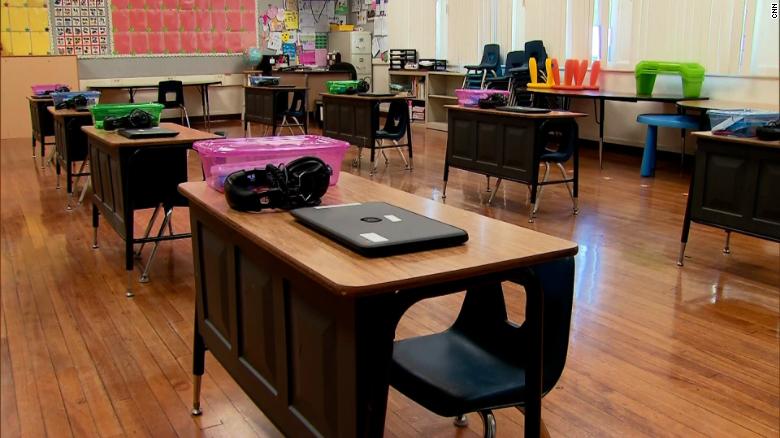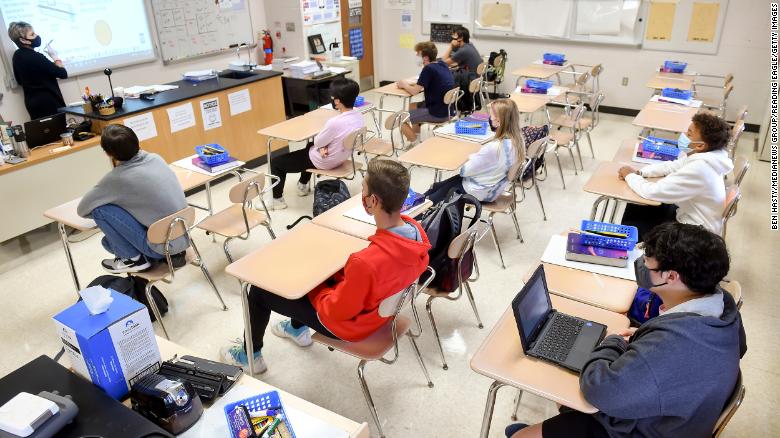
By Ashley Vaughan, CNN
Updated 2:15 PM ET, Fri March 12, 2021

An empty classroom awaits the return of students in Glendale, California.
(CNN)Now more than ever, teachers across the country are stretched thin.
After a year of online or hybrid learning, educators continue to juggle a variety of roles -- including providing tech support to some students -- all while trying to keep safe from coronavirus.
Meanwhile, on the other side of the screen, some students and their families have struggled to keep up. The pandemic's economic fallout devastated vulnerable families, making at-home learning even more challenging.
Fortunately, there are organizations helping teachers, students and their families during the pandemic.
Content by WOW Skin Science
Spring clean your beauty routine, naturally
Put your beauty routine through a spring cleaning with WOW Skin Science
You can donate to any or all charities mentioned in this article by clicking the button below or by going here.
Bridging the digital divide
A study by Common Sense Media and the Boston Consulting Group reports 16 million children in the US lack internet access or laptops for virtual learning.
In a recent CNN opinion article, Derrick Johnson, the president of the NAACP, and Geoffrey Starks, the commissioner of the Federal Communications Commission, argued that internet access is a modern necessity.
"Full participation in 21st century society requires everyone to have a reliable broadband connection to access work, healthcare, education and government resources," they wrote.

According to a poll from the National Parents Union, more than 70% of parents reported their child as enrolled in either part-time or full remote online learning.
The Lifeline program of the FCC allows for eligible subscribers who identify as low-income to qualify for a monthly discount of $9.25. Monthly discounts of up to $34.25 are available to qualifying members on tribal lands. The FCC says discounted offers are available to qualifying subscribers in every state, commonwealth, territory and on tribal land.
Allconnect provides resources to locate "the best cheap internet" near one's home. For low-income families, the organization provides a guide to find "government assistance, income-based and provider-specific programs." On its website, Allconnect has a resource list of major internet providers offering discounted internet services. For pricing details, click here.
Similarly, the National Digital Inclusion Alliance offers a list of current providers with discounted rates for eligible families. Listed offers are less than $20 a month with no installation fees.
Through its ConnectAll initiative, InterConnection provides families in need of internet-enabled devices with opportunities to buy technology at a discount. InterConnection also offers free shipping for all of its computers, excluding Hawaii and Alaska.
Comp-U-Dopt places technology into the hands of students in underfunded communities. The organization says a $275 donation will pay for one student's computer.
Comp-U-Dopt has programs in Chicago, Los Angeles, New Orleans, Washington, DC and several Texas cities (Corpus Christie, Dallas, Fort Worth, Galveston, Houston, San Antonio and Midland).

In a 2018 survery from AdoptAClassroom.org, 96% of teachers reported having to purchase classroom supplies for their students.
Contributions to Digital Wish provide mobile hotspots to make education accessible everywhere. The organization is on a mission to connect one million students to mobile wifi. Digital Wish accepts technology hardware donations which get "responsibly recycled" with proceeds going toward the purchase of hotspots.
Support for teachers
In a recent survey conducted by the Annenberg Institute at Brown University, over half of the sampled teachers reported declining feelings of success during the epidemic and having to teach remotely. For decades, teachers routinely made sacrifices in their already demanding careers. According to a 2018 survey from AdoptAClassroom.org, 96% of teachers reported having to purchase classroom supplies for their students.
To champion teachers and support their efforts, consider donating to the organizations below:
-
AdoptAClassroom.org has launched a Covid-19 Relief Fund for teachers and students. Donations will help pay for hotspots and Chromebooks for students, PPE, and necessary supplies requested by teachers. AdoptAClassroom also enables donors to fund individual teachers and schools. To find a school or a teacher to support click here:
-
DonorsChoose offers a simplified way for donors to find and fund campaign projects created by teachers across the US. Campaigns include a range of education issues from literacy to emotional support. The organization strives to make sure every student in "every community has the tools and experiences they need for a great education." To search for teacher campaigns to support, click here.
In addition to cash, Kids in Need Foundation accepts donated supplies that help educators across the country stock their classrooms. Needed items include crayons, erasers, pencils, and hand sanitizer. To bolster donations, the non-profit offers a downloadable guide on how to host a "DIY Supply Drive" on their website.
Kids in Need Foundation also offers donation options for business owners as well. With the help of everyday people, the organization says it has provided an estimated $100 million worth of supplies to teachers and students across the country.
Nutrition for children
According to Feeding America, more than 42 million people may experience food insecurity during the pandemic. The organization says this potentially includes 13 million children.
Feeding America has created a Covid-19 Response Fund. The non-profit says that each donated dollar will help food banks across the country. Similarly, Blessings in a Backpack is helping fill the gap of providing meals for children who no longer can receive school lunches or breakfasts. The organization says a donation of $4 "provides a Blessing Bag of food to a child facing food insecurity."

Boxes of food are distributed by the Los Angeles Regional Food Bank.
On its website, Save the Children reports nearly 1 in 5 children grows up in poverty in the US. Backdropped by the pandemic, vulnerable families must do much more with less -- and oftentimes it is not enough. Since the start of the pandemic, Save The Children has prepared and delivered meals to children who counted on in-school dining. So far, the organization has helped prepare and deliver more than 18 million meals. On its website, the organization offers downloadable educational toolkits to help parents support their child's education at home. The kits also suggest helpful language for parents to help with difficult conversations about the pandemic.
In response to Covid-19, the United Way has been helping families and children in a number of ways. The organization says it has served more than 33 million meals to families in need. In addition to food, the organization provided rent and mortgage assistance to more than 100,000 households and has paid more than 100,000 utility bills, which support children attending class online. The organization also helped families of essential workers buffer the costs of child care. The United Way says more than 24,000 households received financial help with child care through its local chapters.
Little Free Pantry created a grassroots movement mobilizing people to create "free pantries" outside their homes so those in need can easily receive direct relief. The mission encourages neighborhoods to "Give what you can" and "take what you need." According to the organization, items like canned vegetables, protein drinks, and personal care items go fast. Anyone can set up a pantry in their yard and can join the national movement here.

Free Little Pantry is a grassroots movement in which individuals and neighborhoods can provide direct relief to those in need of food or essential items.
World Central Kitchen also stepped up to join the fight against hunger. In response to Covid-19, the organization distributes individually wrapped meals for children and families to pick up and take home. Throughout the pandemic, World Central Kitchen says it provided more than 30 million meals across more than 400 cities.
The Meals for Kids Finder operated by the US Department of Agriculture is a useful tool to connect children who normally receive free or reduced school lunch with needed meals. The search portal identifies distribution sites near a child's home by zip code or home address.
The US Department of Agriculture also offers a toll-free number 1-866-3-HUNGRY or 1-877-8-HAMBRE (Spanish) to support families in need of food assistance. The hotline is staffed Monday through Friday between 7 a.m. to 10 p.m ET.
CNN's Lauren Lee, Mayra Cuervas, and Jennifer Grubb contributed to this report.
|